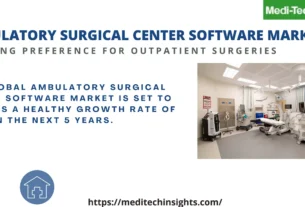The global STD diagnostics market is experiencing significant growth, driven by rising sexually transmitted diseases (STDs) cases, technological advancements in diagnostics, and heightened awareness about early detection and prevention of STDs.
Get A Free Sample PDF of Our Research Report : https://meditechinsights.com/std-diagnostics-market/request-sample/
What is STD Diagnostics?
Sexually Transmitted Disease (STD) Diagnostics refers to various methods and procedures used to detect sexually transmitted infections (STIs) in individuals. Accurate and timely diagnosis is crucial for the effective treatment and prevention of further transmission. Common STD diagnostic methods include:
- Blood Tests: Detect antibodies or markers for infections like HIV, syphilis, and sometimes herpes.
- Urine Tests: Used to identify pathogens related to chlamydia and gonorrhoea.
- Swab Tests: Collect samples from genital, anal, or oral areas for testing, often used for chlamydia, gonorrhoea, and herpes.
- Molecular Diagnostics: Advanced techniques like polymerase chain reaction (PCR) detect the genetic material of pathogens, highly sensitive for STDs like HPV and HIV.
- Point-of-Care Tests (POCT): Rapid tests that offer quick results at the testing site, reducing the need for lab-based testing.
- Serological Tests: Essential for identifying infections like syphilis by detecting antibodies in the blood.
By utilizing these tools, healthcare providers can diagnose STDs early, leading to timely intervention, treatment, and prevention of further spread.
Key Growth Drivers in the STD Diagnostics Market
Several factors are fueling the growth of the STD diagnostics industry:
- Rising STD Cases: The increasing prevalence of STDs like HIV, syphilis, gonorrhoea, and chlamydia globally underscores the demand for reliable diagnostics. Early detection is critical to prevent complications such as infertility or certain cancers.
- Technological Advancements: Modern diagnostic technologies, including nucleic acid amplification tests (NAATs) and rapid tests, offer higher accuracy and faster results, revolutionizing the field.
- Growing Public Awareness: Increased awareness about the importance of STD screening and early detection has boosted the demand for diagnostic solutions.
- Government Initiatives and Programs: Public health campaigns, funding, and education programs aimed at STD prevention and control are helping drive the market. For example:
- In December 2023, MedMira Inc. received FDA approval for its Advanced Reveal G4 Rapid HIV-1/2 Antibody Test, gaining 510(k) clearance in the U.S.
These factors collectively push the STD diagnostics market toward strong growth in the coming years.
Technological Innovations in STD Diagnostics
Innovative technologies are shaping the future of STD diagnostics. Advanced techniques like Next-Generation Sequencing (NGS), CRISPR-based diagnostics, and microfluidic technologies are expected to improve diagnostic accuracy and accessibility. These advancements will enable early detection, enhance treatment precision, and facilitate better patient outcomes. For instance:
- In May 2022, Abbott received FDA clearance for the Alinity™ m STI Assay, a multiplex test that detects four common STIs using advanced molecular PCR technology.
Moreover, the rise of Point-of-Care Testing (POCT) for STD diagnostics is making testing more accessible. POCT provides swift results and is suitable for use in diverse settings like community clinics, outreach programs, and rural areas. Simultaneously, home-based STD testing kits are becoming more popular, driven by concerns about privacy and convenience, significantly broadening the market’s reach.
Regional Market Insights
The STD diagnostics market varies by region:
- North America: A well-established healthcare infrastructure, combined with widespread awareness, is driving the adoption of STD diagnostics. Government support and private sector investments are also propelling growth, particularly in response to rising STD rates in key demographics.
- Europe: With advanced healthcare systems and high awareness of STD screening, the region benefits from technological advancements, though regulations may differ between countries.
- Asia Pacific: Rapid economic growth, increasing healthcare expenditures, and heightened awareness of STDs are fostering market expansion. Countries like China and India present significant opportunities due to their large populations and increasing adoption of point-of-care testing.
Competitive Landscape and Growth Strategies
Key players in the STD diagnostics market include:
- Abbott Laboratories
- MedMira Inc.
- Cepheid (Danaher Corporation)
- F. Hoffmann-La Roche AG
- bioMérieux
- Bio-Rad Laboratories
- OraSure Technologies, Inc.
These companies are adopting both organic and inorganic strategies, such as partnerships and acquisitions, to gain market share. For example:
- In December 2021, the U.S. Centers for Disease Control and Prevention (CDC) allocated funding to nearly 30 organizations to combat antimicrobial resistance (AMR), including efforts to address resistant strains of gonorrhoea.
Conclusion: STD Diagnostics Market Outlook
The STD diagnostics market is set for sustained growth, driven by the rising incidence of STD infections, increasing awareness of the importance of early detection, technological advancements, and aggressive growth strategies by leading players.



